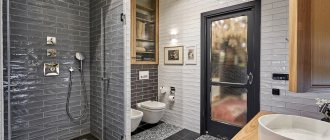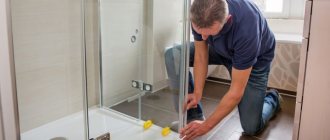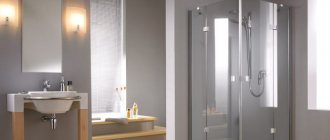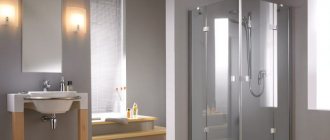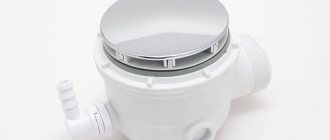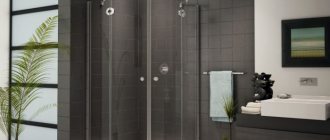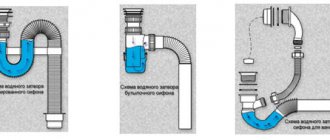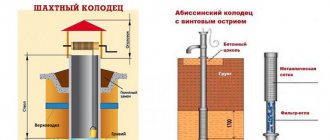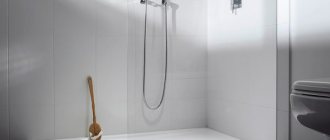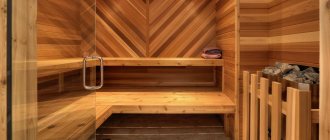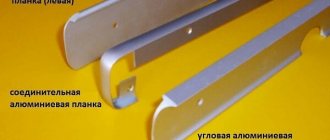In modern interiors, a shower stall with a large tray is often replaced with structures with thin transparent or matte walls installed on the floor. Installing a shower cabin without a tray may seem simple. But this is only at first glance.
In practice, installing a compact structure requires basic skills and strict adherence to installation rules, do you agree with this?
Do you want to install a shower stall yourself, but don’t understand what materials and components are needed for this? Let's figure out all the nuances of this process together - our article provides detailed instructions on how to build a shower without a tray.
Each stage of work was examined in detail, and visual photographs were selected to illustrate the described points. And in addition to the article, we have added videos that clearly demonstrate the installation process of such plumbing fixtures.
Shower cabins in the interior
Fashionable modern interiors are distinguished by ergonomics, lightness and free space. For this reason, designers have developed compact and stylish shower designs without a tray.
Thin, often transparent, enclosures of the cabin are mounted on the floor of the bathroom, where a drain is immediately installed, thanks to which the practical shower box plays the role of an integral element of the interior.
A shower box without a tray is used to organize a small bathroom and a spacious room. The variety of models allows you to embody creative design ideas in interior design.
Since the walls of the shower cabin are usually made of the thinnest transparent plastic, the design looks airy and light. An important advantage of a shower box without a tray is that its installation requires minimal space.
A shower without a tray will not only successfully cope with its intended purpose, but will also stylishly transform the interior of the bathroom
Manufacturers often use transparent or organic frosted glass as shower partitions. After taking a shower, no traces of water drops remain on the glass surface.
The nuances of choosing and installing glass for a shower are discussed in our other article.
Depending on the features of the bathroom interior, you can equip the shower stall with plastic panels, block walls, glass blocks, etc.
A shower box with partitions made of double durable glass, inside of which LEDs or lighting are mounted, will create an original interior.
A shower cabin with lighting is often used by modern designers. The original design can play the role of an accent element in the bathroom design
To make a shower stall look stylish, you need to choose the right materials, so it makes sense to turn to designers to create a project.
A non-standard floor covering will significantly improve the design of a shower box. The floor of the cabin is covered with ceramic tiles, which do not necessarily have to match the style of the walls and other surfaces of the bathroom.
The ceramic floor of the shower box, lined with contrasting mosaics, is an excellent solution for decorating a modern interior. Before starting facing work, it is necessary to perfectly level the surface
The floor looks original in the form of a mosaic, decorated with drawings or additional decorative elements.
Grouting and cleaning
1-2 days after finishing the cladding work, grout the joints. To ensure sealing of gaps between tiles, use mixtures that have fungicidal and moisture-resistant properties.
After 5-6 hours, depending on the type of composition, clean the surface of the tiles from excess fugue with a damp sponge or soft cloth, remove the tape from the drain grate.
Installation of cabin doors
You can install two types of doors in the shower:
- sliding or folding - opening along the cabin wall using a roller mechanism. The installation of the canvases is carried out on horizontal guides attached to the base and vertical profile;
- hinged (single- or double-leaf) - mounted on hinges that are fixed to the wall or metal frame. The canvas is equipped with a seal to ensure tightness and silent movement.
For small bathrooms, it is advisable to use sliding doors, which significantly saves space.
Installing a heated floor over the entire area of the bathroom or only in the bathing area will help make water procedures as comfortable as possible. When choosing the design of a shower corner without a tray with tiles, focus on the size of the bathroom, the quality and pressure of the water - the choice of materials used and the functionality of the shower will depend on this.
Advantages of boxes without pallets
A shower installed on the floor can significantly save space and can be used in rooms of different purposes and sizes.
Before installing a compact booth, you need to evaluate its advantages and disadvantages.
Unlike a bathtub, a shower box without a tray takes up little free space, so installing it will save room space
Main advantages of the device:
- Small sizes. A shower without a tray can be installed in a small bathroom.
- Design advantages. The aesthetic design will allow you to stylishly decorate your bathroom interior. A shower box without a tray will harmoniously fit into the interior of a country house or city apartment.
- Easy to use. Ideal for people with disabilities, the elderly and children.
- Hassle-free care. Thanks to the simple device, maintaining and cleaning the booth will not be difficult and will not take much time.
- Possibility of self-installation. Installation can be carried out with your own hands, subject to strict adherence to the rules.
In addition, such hygienic facilities cost significantly less than shower stalls with a tray, which allows you to save your budget.
A comfortable and ergonomic shower stall without a tray is designed for installation in a workplace, apartment or private home. The compact design is also suitable for installation in a swimming pool or sports complex.
Image gallery
Photo from
Shower corner with colored tiles
Comfortable low side
Wide range of design possibilities
Economical and stylish shower solution
Bathing area dimensions
To determine the optimal dimensions of a future tile shower without a tray in an apartment, be guided by the following selection criteria:
- bathroom size. For comfortable swimming in a small room, a 100x100 cm cabin is suitable. If the room is large, choose the design dimensions at your discretion;
- ceiling height. The peculiarity of the building's floors may require raising the floor level in the room by at least 10 cm, so in a low bathroom it will look unaesthetic;
- if the shape of the room is non-standard or irregular, it is advisable to make a shower room with asymmetrical walls, which will also help visually correct the geometry of the room;
- Features of those living in the house: large, overweight people will find it uncomfortable to bathe in a small shower.
The minimum size of the walls of the shower area is 70x70 cm.
Features of the design of shower cabins without a tray
The main distinguishing characteristic of a shower box of this design is the absence of a special tray with characteristic side edges. The cabin of any model is equipped with a shower drain that drains water from the shower head.
When you go looking for a shower box, you can choose the best option among a huge range of models. Modern cabins are divided into several main types and differ in the material used to make the elements and in the configuration.
You may be interested in the information on choosing the best shower stall, outlined in our other article.
Image gallery
Photo from
Shower cabin without standard tray
Using bathroom walls as fencing
Arrangement of the bottom of the shower stall
Slope device towards the drain
Priority wall material
When choosing the optimal design of a shower box, the owner of the room must first decide on the wall material.
Plastic partitions
Partitions can be made of durable, high-quality plastic, which looks impressive and weightless.
The use of plastic partitions for home showers is less popular than glass ones. This material is most often used in the construction of public showers.
The advantages of this material are wear resistance, ease of maintenance and relatively low cost.
Glass shower walls
Glass is the most popular material for making the walls of a shower box without a bulky tray. It can be transparent, matte or combined. Today, the market offers an assortment of original iridescent and colored options.
Glass partitions in the bathroom visually increase the space of the room. Cabin doors are made of ordinary or organic glass.
The walls can become a decoration for a shower box. A bright shower cabin made of colored glass will enliven the interior of your bathroom
The most stable solution for decorating the walls of the box is glass blocks.
Walls made of transparent material will allow you to zone the room and conveniently fence off the corner where the shower stall without a tray is located. Using glass blocks, you can get a separate area for a comfortable shower.
PVC curtains as partitions
Shower curtains made of PVC look elegant and straightforward. By choosing this material, you will create an open shower design that closes during washing.
Curtains provide effective protection against splashes and soap suds. Inexpensive PVC curtains can be changed periodically, which allows you to transform the interior of the bathroom from time to time.
PVC sliding curtains are an ideal solution for a small bathroom. With their help you can make your shower stall more ergonomic.
Owners of country houses sometimes refuse to install partitions. This option causes inconvenience to residents in the form of splashes and foam scattered throughout the entire area of the bathroom. This can cause significant damage to the flooring and furniture.
Choosing a drain for a shower device
An important element of a cabin without a tray is the shower drain. It is responsible for the process of discharging used water into the sewer system, and the comfort of the shower depends on its functioning.
When choosing, you need to consider where the shower and sewer drain will be located, which has several classifications. Products presented by manufacturers may differ in the material of manufacture and location in the shower stall.
Plastic shower drains are popular and are often used in bathrooms. They are resistant to aggressive environments and can withstand significant loads. They are characterized by ease of maintenance and light weight, which ensures ease of installation of the structure.
The products are equipped with a special siphon that does not allow odors from the sewer to pass into the room.
Reliable stainless steel shower drains are usually installed in rooms with special sanitary requirements. Durable structures are characterized by ease of maintenance and installation.
There are also sewer drains made of cast iron. They are used exclusively in large industrial enterprises.
Drain receivers for shower drains made of stainless steel provide the opportunity to install showers without the use of a metal tray. In this case, a semblance of a pallet is built from brick or poured from concrete, reinforced with powerful waterproofing
Based on the type of receiving device and its location, shower drains are divided into two types:
- Spot. The water is drained into a funnel-type hole, towards which a slope is arranged. The funnel is connected to the sewer pipeline. Due to the small size of the receiving device, the waste collection point can be located anywhere: in the center of the shower, in a corner, near the wall of the stall.
- Linear. The most popular type of ladders with maximum receiving capacity. It is an elongated gutter or tray covered with a plastic or stainless steel grid. It is located mainly near one of the walls of the booth. During construction, a slope must be arranged towards the tray.
For arranging a small shower, the point type is better suited. Linear structures are installed mainly in large washing areas.
The linear type of wastewater receiver has a larger area, due to which almost all the flowing water immediately enters the tray, from which it is discharged through a pipeline into the sewer
In addition to these classic types, there is also a hybrid option - a wall drain, which is essentially either a point or a linear type, complemented by a drain receiver built into the adjacent wall. It should be noted that such devices are expensive.
When used correctly, the products used to install wastewater receivers and drainage channels can withstand loads of up to 300 kg, while the temperature of the outlet water can be no higher than 85ºC.
Standard designs are characterized by a drainage volume of 8-15 l/min. A drain tray is also used to remove liquid. It has a high throughput (up to 40 l/min.).
The wall-mounted drain tray is mounted directly against the wall, which significantly increases its throughput and simplifies maintenance of the structure
The drain tray has an elongated shape; its length ranges from 30 to 120 cm. Due to this, it receives a larger volume of liquid than a regular drain.
Types of sealants
Choosing compositions for sealing seams is by no means easy due to the availability of a huge number of different drugs on sale. You need to carefully study the information on the labels, understand the essence of the manufacturer’s recommendations, consult with the seller or manager offering the product, and only then make a purchasing decision.
The sanitary condition of the bathroom, the serviceability of the equipment, and the well-being of the residents depend on the quality of the sealant for the shower cabin and the correctness of its application.
Effective isolation of risk areas is provided by polymer compositions based on:
- silicone;
- acrylic polymers;
- polyurethanes.
All types of products are a viscous paste-like mass, which, when squeezed out of the tube, fills the entire space of the crack, gluing the contacting surfaces.
https://youtube.com/watch?v=Xwn5wPKTn88
Polyurethanes
Composites based on polyurethanes have an aggressive effect on the skin and mucous membranes of the respiratory system; you can only work with them while wearing a protective mask and gloves. Moderate performance characteristics, coupled with the danger of contact, have led to the fact that now polyurethane products cannot withstand competition with more advanced compounds and are gradually losing popularity.
Acrylic polymers
Polyacrylic sealing compounds have a favorable ratio of consumer properties and price, which increases their attractiveness to the buyer. They adhere well to materials due to their high adhesion rates, withstand any temperature, and can be coated with paint, putty or varnish. The desire to purchase acrylic sealants is hampered by their poor resistance to mechanical deformation and the tendency of many modifications of the preparations to be exposed to water.
For example, if you seal the pan with polyacrylate and then allow an overweight person to take a shower, who may well want to give himself a hydromassage, then there is no guarantee that the seams between the lower container and the walls will not crack.
If swimmers with significant weight are not expected, another attack may cause concern. Even composites with added moisture-protective substances cannot withstand prolonged contact with water and slowly decompose, and no one is happy with the prospect of repairing seams in the near future.
Silicone compounds
The leading positions in the ranking of products for sealing shower cabins are consistently occupied by silicones, the consumer characteristics of which make the buyer forget even about relatively high prices.
There are several types of silicone compositions, differing in the structural features of the base substances and the presence of additives.
Composites that contain antifungal additives that increase the viscosity of the mass when drying, plasticizers, and pigments that create a pleasant decorative appearance of the seams can effectively silicone a shower cabin.
Despite the importance of the functions performed by additionally introduced components, the best qualities are those with the maximum concentration of silicone and minimum concentrations of everything else.
Installation of a shower cabin with a drain
Before you begin work on installing a shower box, you should draw up a design design. To install a shower drain and determine where to attach the walls of the cabin, you need to select a water drainage area.
Before installing a shower without a tray, you need to decide in advance on its type and design, and choose a construction scheme. To eliminate errors, you need at least a simple project
To install the ladder, it is necessary to raise it 15 cm from the concrete screed to the floor surface. This makes it difficult to install a shower box without a tray in a city apartment, since you will need to raise the floor level around the perimeter of the room.
If you decide to raise the floor exclusively inside the cabin, you will end up with an inconvenient step when entering the box. Raising the floor throughout the room will result in level floors, but will reduce the height of the bathroom.
Installation work for arranging a modern shower stall without a tray includes several stages.
The following photo gallery will introduce you to the principle of constructing a pallet from building materials:
Image gallery
Photo from
Stage 1: Installation of drain and connection to sewer outlet
Stage 2: Construction of the walls of the shower box
Stage 3: Pouring the screed with a slope towards the drain
Stage 4: Finishing
Stage #1 – preparation of the floor and communications
A guarantee of successful operation of a cabin without a pallet is the correct installation of the floor. To effectively drain water, the base of the floor should be sloped several degrees towards the drain.
A round or square shower drain can be installed in the center of the shower stall. In this case, the floor should have a slight slope on different sides from the corners of the perimeter to its center. If you have chosen an elongated ladder-tray design, then a slope of the floor towards the tray is created.
After installing the drain under the shower stall, you need to install the pipes. It should be noted that sewer pipes must also be located at a slope. Since the floor slope should be 1-2 degrees, it is necessary to ensure the same slope of the sewer pipes.
The floor in the shower is a complex plumbing structure that must be airtight and hide communications. To improve the outflow of water, it is necessary to slope the floor towards the drainage receiver
The concrete base should be thoroughly cleaned of dirt, then treated with a special mastic with high waterproofing properties. It is applied to the floor and walls around the shower stall (25 cm from the floor). This will protect the concrete screed from moisture.
Stage #2 - installing a shower drain
Separately from the shower cabin, you must mount the shower tray and its supports, following the attached instructions. It is necessary to connect all structural elements - siphon, supporting parts, drain and tray pipes.
After assembly, you need to check the quality of installation of the liquid drainage system by pouring water into the drain. If everything is in order, you can install the shower tray on the subfloor.
Before starting work, you need to seal the ladder grating with construction tape. This will prevent various construction debris from entering the sewer system.
The shower drain structure is installed at the first stage separately from the cabin. To do this, all structural elements are connected and the product is checked for functionality.
After installing the shower drain on the subfloor, all exposed areas must be filled with foam or polystyrene blocks.
Their thickness should be from 5 cm, while taking into account the slope of the floor (you can test it using a building level) and the slope of the pipe through which the water drains.
The gaps and cracks on the floor of the structure are filled with a mixture of water, cement and sand. The base of the shower stall is carefully compacted, and the level must be constantly monitored.
After completing the work, you must wait at least 3-4 days until the base of the shower stall floor hardens completely.
Stage #3 – waterproofing the cabin base
The next stage includes additional waterproofing of the base of the shower box. It is permissible to use both coating and pasting materials in the work. Waterproofing is done in 5 – 8 layers.
You may also find information about waterproofing your bathroom useful if your shower is not designed to have walls.
It is advisable to cover not only the base of the booth with a powerful waterproofing layer, but also the adjacent walls to a height of 35–50 cm, and the floor in the hygienic room in case of leakage
High-quality construction work will prevent flooding of neighbors on the lower floors. At this stage, mastic is used, which acts as a sealant. It is applied to the lower part of the walls and to the base made of foam blocks.
A single continuous sheet of roofing felt or fiberglass is then laid over the subfloor to serve as waterproofing. During the installation process there should be no cuts or cracks, since damaged areas may cause leaks and damage to the integrity of the structure.
Waterproofing the walls and floor of a compact shower stall must be carried out especially carefully before the final finishing stage.
The edges of the sheet should be located on the wall surface at a height of 25 cm from the floor level. The material is folded at the corners, pressed against the wall and secured with glue.
Stage #4 - installation of concrete screed
The next stage of installing a shower without a tray is to install a concrete screed on top of the hardened floor covering. In this case, the thickness of the concrete screed must be at least 4 centimeters.
This will ensure the strength and reliability of the structure. During screeding, you should control the degree of slope of the floor towards the drain.
It is recommended to think in advance about exactly how the ceramic tiles will be laid on the subfloor and to place the strips on the screed. Due to this, the concrete floor will be reliably protected from cracking due to temperature changes during the operation of the shower cabin.
The concrete screed is covered with mastic, which acts as a waterproofing material. Coat the base of the shower floor and the lower surface of the walls to a level of 25 cm.
The screed is poured into a pre-constructed formwork. The solution should be poured without interruption in one step; it is advisable to use a vibrator to remove air bubbles from the pouring body
Stage #5 – finishing and decoration
At the next stage, they move on to finishing the structure. The floor and walls of the shower box are laid out with ceramic tiles or decorative mosaics.
During the finishing process, you must first tile the floor of the structure, and then the walls. Due to this, the vertical wall tiles will cover the horizontal ones below. After laying the tiles, the wall joint and all joints should be carefully treated with waterproofing film or silicone.
The concrete base is covered with tiles on top, which are laid at a certain angle to the drain. The seams between the tiles are covered with waterproofing film.
The last stage is the final design. The boundaries of the shower box can be in the form of a reliable partition, which is built on the basis of cinder blocks, finished with ceramic tiles or mosaics. Most consumers install glass doors.
If the base of the shower stall is made in the shape of a circle, round doors are used. When constructing a rectangular or square base of the box, the doors of the structure are placed perpendicular to each other.
To install a structure without a pallet, guards must be installed. To do this, you can use brick partitions, cinder block fences, plastic or glass doors.
The most popular material used for the manufacture of sashes is durable glass. When washing in the shower, no smudges or stains remain on it. The thickness of the glass sashes varies from 6 to 12 mm, and the material can be transparent, matte or a combination.
Shower enclosures are often made of glass. Convenient sliding design does not clutter the room and makes the space light and weightless
At the last stage, you need to install a shower head.
DIY penetrating waterproofing
Installation of a built-in ladder in the absence of a pallet
Penetrating waterproofing is a material that has recently gained popularity in the construction market. The advantage is ease of use, and the technology of the device is considered the simplest. The sequence of actions is as follows:
- The mixture is diluted with some warm water.
- Stir until smooth.
- Apply with a brush to a previously cleaned base.
In this case, more attention should be paid to the junction points of the pipes. Also, don't walk past walls. First, they need to be cleaned of sagging, old paint and other various contaminants, and then cracks, potholes or other defects must be sealed with an insulating compound.
It will be enough to apply coating waterproofing in one layer. But in places of increased danger, where moisture regularly enters, it is better to make an additional layer in order to avoid possible unpleasant consequences in the form of rotting of the surface of the floor, walls, and corrosion of pipes.
Prevention of installation errors
Modern shower boxes without a tray differ from other models in that the water drains directly through a drain installed on the floor of the structure. The main task when installing a shower without a tray is to correctly set the floor slope and properly waterproof the base.
If the technology is violated during the installation of the floor and shower drain, the consequences can be serious. There is a possibility of flooding of neighbors, and if a “warm floor” system is installed in the bathroom, a short circuit is possible.
Therefore, laying the floor and other work on installing a shower cabin without a tray must be carried out in compliance with the technology and installation rules.
If the siphon is installed incorrectly, an unpleasant odor may appear, which usually comes from the sewer system. Therefore, it is recommended to choose a high-quality drain made by a popular manufacturer.
When assembling the structure, you must strictly follow the instructions supplied with the product.
Using Corner Tape
Corners are also potentially "dangerous" in terms of cracking, so it is necessary to use reinforcing tape for corners. Usually, the manufacturer offers a similar tape for this or that waterproofing - self-adhesive or not. In any case, you must use this tape. When choosing a tape, you should give preference to the one that stretches well - well, everything is clear here.
As a last resort, instead of special tape, you can use durable, porous fabric like a thick construction bandage.
Requirements for covering the floor and walls in the shower room
When creating a shower stall with your own hands in an apartment with a drain, you need to think through all the structural elements. The choice of finishing materials is of particular importance. The optimal solution would be tiles. At the same time, it should be non-slip. Therefore, they choose a material with a special coating.
If desired, you can lay tiles made of natural or artificial stone on the floor. However, it is quite thin - no more than 3-4 mm. In this case, the thickness of the tile should be 8-10 mm, and the adhesive coating should be 4-9 mm.
Additional purchases
You can watch how to properly apply sealant with your own hands in special videos.
It’s better to note a few things you need to buy that will definitely come in handy during the renovation:
- Masking tape: This will help protect surfaces from sealant while working. It is glued along the seam, and after drying it is peeled off.
- Protective mask (respirator) and gloves: many sealants, although odorless, remain chemically hazardous substances, and therefore it is better to protect your health in advance;
Please note: the door must always be open for ventilation during operation.
- A special knife for removing silicone sealant: it is easy to remove fresh silicone if it comes out of the seams. Also, the tool is easy to remove the excess that sticks out unsightly above the seam.
- Special chemical solvents for old silicone: before applying a new layer, it is necessary to clean off the old one. If the layer is quite old, you will need to soften it using special substances. “Silicon Remover”, the Dutchman “Sili-Kill” and “Permaloid” have proven themselves well: brand “7799” is suitable for removing paint and metal, and “7010” is suitable for plastic and acrylic.
Engineer's Note: When selecting a sealant softener, it is important to check whether it is suitable for the specific material. Installation of any shower cabin requires sealing using special means. This is necessary to protect the seams from moisture, as well as to prevent the formation of mold.
This is necessary to protect the seams from moisture, as well as to prevent the formation of mold.
Installation of any shower cabin requires sealing using special means. This is necessary to protect the seams from moisture, as well as to prevent the formation of mold.
Watch the video, which clearly shows the process of applying sealant in a shower stall:
See inaccuracies, incomplete or incorrect information? Do you know how to make an article better?
Would you like to suggest photos on the topic for publication?
